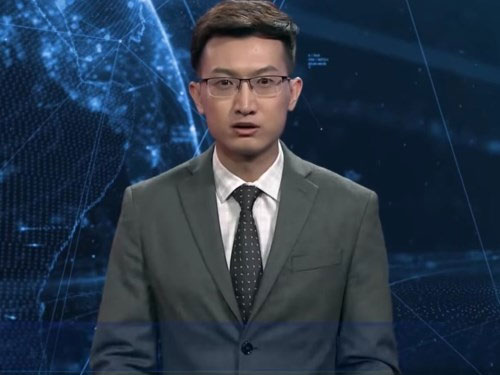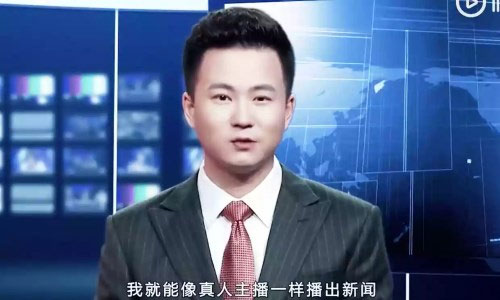The truth behind the world's first AI announcer
The China National News Agency has just released a news presenter with artificial intelligence (AI) with the same look and lead as people.
Xinhua News Agency, the official news agency of the Chinese government, has just been surprised to announce the AI that led the world's first news program . Simulated images from the two hosts of the radio, AI can read and guide the news in English and Chinese.
'The two AI hosts have officially become members of the Xinhua news agency, they will work with other editors to edit and deliver accurate and timely news in both languages on the channel. image of the company ', representative of Xinhua said.

AI host on English newsletter of Xinhua News Agency.(Photo: New China TV).
In the speech, Xinhua said the AI guide can operate 24 hours a day on all media, from websites to social networking sites and radio channels, helping to reduce the cost of producing news articles. and improve the efficiency of work.
The news agency has developed new technology with Sogou, the second largest search engine company in China. Stakeholders have yet to disclose exactly how they did this, but AI has been so thoroughly trained that it can naturally host people.
The agency said its artificial intelligence had learned to guide itself through observing other news reports. AI when broadcasting on television will read news from the text that has been edited.'I will work tirelessly to keep you up to date, the news put into my system will never be interrupted', the AI guide said in the first English newsletter with a total voice. well suited.

AI host on Chinese newsletter.Real person images and voices are taken from the show host Qiu Hao.
AI host images and voices are taken from real people, but mouth movements and facial expressions are synthesized from computers. It is easy to see, the facial expression is still limited, the voice is still bold from the synthesized sound of the robot, the modified image is matched with words, not naturally emitted.
Artificial intelligence and communication industry
In the period when editorial staff was decreasing, the amount of information needed to be published increased dramatically, newspapers were gradually heading to AI as a savior. The AP news agency has joined hands with Automated Insights and released data reports from 2014.
BBC News uses Juicer as an information filtering tool. This technology filters information continuously from 850 newspapers worldwide and extracts citation information from there. It will arrange information in four forms: organizations, places, people, events, helping reporters who want to find information will be much easier.

Artificial intelligence was present in the communications industry and gradually replaced many people's jobs.
In 2016, Reuters teamed up with Graphiq technology to launch a series of interactive data on various categories such as sports, entertainment, politics, with real-time updates. This is a new way to easily attract readers and put data into the article in an eye-catching, non-dry and understandable way.
The Washington Post began experimenting with AI journalism using Heliograf. They started applying this technology in the summer of 2016 to launch articles about the Olympic Games in Rio de Janeiro, giving accurate analysis of what happened and posting on various platforms.
Guardian newspaper also released its Chatbot on Facebook in 2016. To save time to pull the News Feed down to view each article, this chatbot allows users to choose the US, British or Australian publications of the Guardian, choose the interval newsroom and it will automatically send well-defined articles to each person, every day via text message on Facebook Messenger.
China's artificial intelligence and ambition
China aims to develop itself into a strong nation in the field of artificial intelligence. The announcement of this new technology not only introduces new products in the technology sector and the media industry, but also affirms the country's capabilities.
The billion-dollar nation has continuously promoted the application of artificial intelligence in everyday life, from self-driving cars and military submarines to face-recognition technology for security purposes. The domestic AI industry has grown by 67% in the past year and by 2030, it will lead the world in AI.

Just by relying on facial images, voice sounds or gait, the Chinese government's artificial intelligence system and giant server will quickly identify the identity of any person.
Across the country, hundreds of millions of surveillance cameras are placed to monitor and identify people. Just relying on the face image or the sound of the voice, the artificial intelligence system will quickly identify that person's identity and record it into the system.
Beyond that, Chinese company Watrix has just launched a new technology that helps identify a person based solely on their gait. Accordingly, a person who, although standing 50 meters away from the camera to monitor and cover his nose, can still be identified only because of his gait and accurate rate of up to 94%.
WeChat, the online multifunctional platform, handles up to 7 billion photos a day and a great deal of them are done automatically by computers. But this number of images not only handles them to make them more beautiful or lightweight, but also serves to verify the identity of the user.
- China launches the world's first female virtual radio announcer
- The Massachusetts Institute of Technology says China's virtual broadcasters are only fake
- The world's first robotic announcer
- Close up of robot beautiful Japanese TV announcer
- The truths always amaze you about the biological world
- France blocks 'gate connecting the worlds'
- Discovering many cosmic mysteries, people yearn to find new worlds
- Does a true drug exist?
- The truth is that you do not know about the types of ink in the world
- 7 truths are extremely unbelievable about the world, but you are not sure
- Unbelievable facts about the Earth
- 17 'truth' about the Earth and the universe is true but has been rejected by science
 The world's first sexless AI voice
The world's first sexless AI voice This cool t-shirt will make you invisible to AI
This cool t-shirt will make you invisible to AI AI can predict personality only through selfie photos
AI can predict personality only through selfie photos The world-famous chess player lost to Golaxy before, artificial intelligence 'made in China'
The world-famous chess player lost to Golaxy before, artificial intelligence 'made in China'